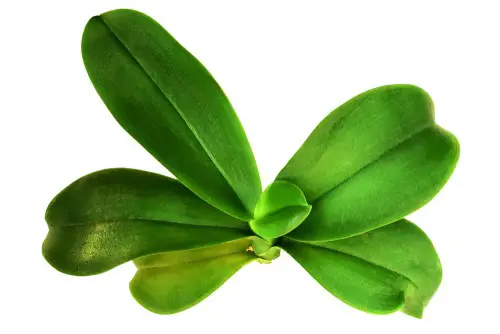Orchids are beautiful and delicate plants, but they can be quite finicky when it comes to their care. One common issue that orchid owners face is the tips of orchid leaves turning brown. While this may seem like a minor problem, it can actually be a sign of a larger issue with the plant’s health.
Understanding why orchid leaves turn brown can be a bit tricky, as there are several factors that can contribute to the issue. Some of the most common causes include overwatering, underwatering, improper lighting, disease and infection, and nutrient deficiencies.
By identifying the root cause of the problem, however, orchid owners can take steps to address the issue and prevent further damage to the plant.
Key Takeaways
- Orchid leaves turning brown can be a sign of a larger issue with the plant’s health.
- Common causes of brown orchid leaves include overwatering, underwatering, improper lighting, disease and infection, and nutrient deficiencies.
- Identifying the root cause of the problem is key to preventing further damage and restoring the plant’s health.
Check out these other popular posts in this category:
Understanding Orchid Leaves Turning Brown
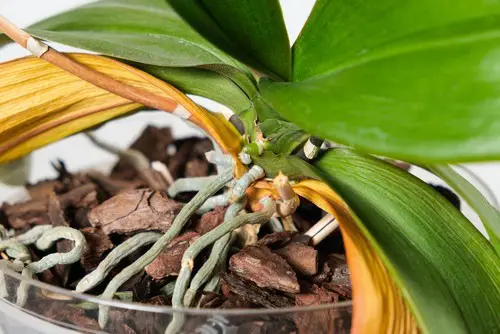
Symptoms of Browning Leaves
Orchid leaves turning brown is a common issue that orchid growers face. The first symptom of browning leaves is the discoloration of the leaves, which starts from the tips and gradually spreads to the rest of the leaf if left untreated.
The leaves may also become leathery and limp, and develop deep wrinkles and grooves. In severe cases, the leaves may dry up and fall off the plant.
Common Causes of Brown Leaves
There are several reasons why orchid leaves turn brown. One of the most common causes is overwatering or underwatering. When orchids are overwatered, the roots may become waterlogged, leading to root rot.
This can cause the leaves to turn brown and wilt. On the other hand, underwatering can cause the leaves to dry out and turn brown.
Another common cause of browning leaves is exposure to direct sunlight or extreme temperatures. Orchids are sensitive to temperature changes, and exposure to extreme temperatures can cause the leaves to turn brown. Additionally, exposure to direct sunlight can cause the leaves to burn and turn brown.
Overfertilizing can also cause orchid leaves to turn brown. When orchids are overfertilized, the roots may become damaged, leading to nutrient burn. This can cause the leaves to turn brown and wilt.
In some cases, pests and diseases can also cause orchid leaves to turn brown. For example, spider mites, scale insects, and mealybugs can all cause damage to the leaves, leading to browning and wilting.
The Role of Watering
Watering is a crucial aspect of orchid care and can have a significant impact on the health of your plants. In this section, we will discuss the importance of watering, including over-watering and under-watering, water quality, and humidity levels.
1. Over-Watering and Under-Watering
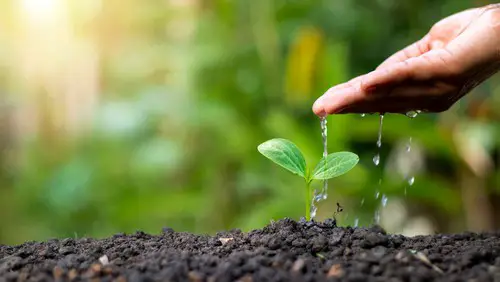
Over-watering is one of the most common watering problems with orchids. It can lead to root rot and brown spots on the leaves. Signs of over-watering include soft, mushy roots, yellowing leaves, and a foul odor. To prevent over-watering, it is essential to allow the potting mix to dry out partially before watering again.
On the other hand, under-watering can cause the orchid leaves to turn brown and dry out. Signs of under-watering include wrinkled or shriveled leaves and a dry potting mix. To prevent under-watering, it is important to water the orchid when the potting mix is almost dry.
2. Quality of Water
The quality of water used to water orchids can also affect their health. Orchids are sensitive to chemicals found in tap water, such as chlorine and fluoride. Using well water or filtered water can help prevent the buildup of these chemicals in the potting mix.
It is also important to avoid using softened water to water orchids because it contains high levels of salt, which can damage the roots and cause brown spots on the leaves.
3. Humidity and Orchids
Orchids thrive in environments with adequate humidity levels. Low humidity can cause the orchid leaves to turn brown and dry out. To increase humidity levels, a humidifier or a humidity tray can be used.
A humidity tray is a shallow tray filled with water and placed under the orchid pot. The water in the tray evaporates, creating a humid micro-climate around the orchid. This can help keep the leaves looking their best.
Temperature and Lighting Effects
Temperature Requirements
Orchids are sensitive to temperature changes. They require specific temperature ranges to thrive. The ideal temperature range for orchids is between 60°F to 80°F during the day and 55°F to 65°F at night.
If the temperature drops below 55°F, it can cause cold damage to the orchid leaves. On the other hand, temperatures above 80°F can cause dehydration and lead to browning of the leaf tips.
Lighting Needs
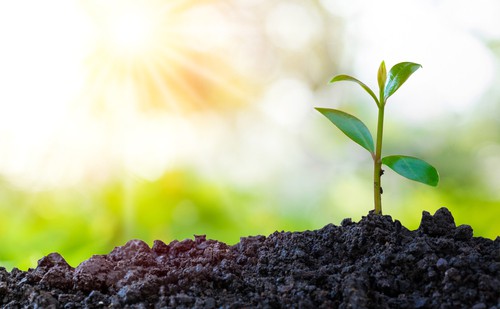
Lighting is another crucial factor that affects the health of orchids. Orchids require bright, indirect sunlight to grow and bloom properly. Too much sun or excessive sunlight can cause sunburn, which may lead to brown spots or browning of the leaf tips.
Orchids require 12-14 hours of light per day to grow properly. If the orchid is not receiving enough light, the leaves may turn yellow and eventually brown. If the orchid is receiving too much light, the leaves may turn brown and dry out.
It is essential to find the right balance of light and shade for your orchid. A good rule of thumb is to place your orchid in a location where it receives bright, indirect sunlight for 6-8 hours a day. If you notice that the leaf tips are turning brown, it may be due to inadequate lighting or too much sunlight.
Disease and Infection
Orchids are susceptible to various diseases and infections that can cause the tips of their leaves to turn brown. These issues can arise due to bacterial infections, fungal diseases, or other causes. It is essential to identify the underlying problem accurately to provide appropriate treatment.
Bacterial Infections
Bacterial infections are a common cause of brown spots on orchid leaves. The bacteria Pseudomonas cichorii and Erwinia are the most common culprits. Symptoms of bacterial brown spot include brown-black spots with yellow halos on the leaves. The spots may enlarge and merge, causing the leaves to become yellow and die.
Treatment of bacterial brown spot involves removing the infected leaves and spraying the plant with a bactericide. Copper sprays or antibiotics can also be used to control the spread of the bacteria.
Preventing bacterial infections involves maintaining good hygiene practices, such as avoiding overwatering and providing adequate air circulation.
Fungal Diseases
Fungal diseases are another common cause of brown tips on orchid leaves. Fungi such as black rot, anthracnose, and septoria can cause the leaves to turn brown and die. Symptoms of fungal diseases include brown spots with black margins, yellowing of leaves, and wilting.
Treatment of fungal diseases involves removing the infected leaves and spraying the plant with a fungicide. Copper sprays or sulfur-based fungicides are effective in controlling the spread of fungi.
Preventing fungal diseases involves maintaining good hygiene practices, such as avoiding overwatering and providing adequate air circulation.
Fertilization and Nutrition

Proper fertilization and nutrition are crucial for maintaining healthy orchids and preventing the tips of their leaves from turning brown. In this section, we will discuss the key factors to consider when fertilizing orchids.
Choosing the Right Fertilizer
When choosing a fertilizer for orchids, it is important to select one that is specifically formulated for these plants. Orchids have unique nutritional requirements that differ from other houseplants, so using a general-purpose fertilizer may not provide the necessary nutrients.
Look for a fertilizer that has a balanced ratio of nitrogen, phosphorus, and potassium (N-P-K), as well as trace elements such as iron, magnesium, and calcium. Some orchid fertilizers also contain beneficial bacteria and fungi that can improve soil health and nutrient uptake.
Proper Fertilization Practices
Over-fertilizing orchids can cause fertilizer burn, which can lead to brown tips on the leaves. To avoid this, it is important to follow proper fertilization practices.
First, always dilute the fertilizer according to the manufacturer’s instructions. Applying too much fertilizer can cause a buildup of salts in the soil, which can damage the roots and lead to nutrient deficiencies.
Second, fertilize orchids during their active growing season, which is typically in the spring and summer. During the dormant season, which is usually in the fall and winter, orchids require less fertilizer.
Third, apply fertilizer evenly to the soil surface, avoiding contact with the leaves or flowers. Fertilizer that comes into contact with the leaves can cause leaf burn, which can also lead to brown tips.
Fourth, water orchids thoroughly after fertilizing to help distribute the nutrients evenly throughout the soil.
By following these proper fertilization practices, orchid owners can help ensure that their plants receive the necessary nutrients without causing damage to the leaves or roots.
Orchid Root Health
Orchid root health is crucial for the overall health and well-being of an orchid plant. Brown tips on orchid leaves can be a sign of root problems. In this section, we will discuss how to identify root problems and the importance of repotting orchids.
Identifying Root Problems
Root problems in orchids can be caused by various factors such as overwatering, poor drainage, and fungal or bacterial infections. One of the most common root problems in orchids is root rot, which can be identified by brown, mushy roots.
To check for root rot, gently remove the orchid from its pot and inspect the roots. Healthy roots should be firm and white or green. If the roots are brown, mushy, or have a foul odor, it is likely that the orchid has root rot.
Another common root problem is dehydration, which can cause the roots to become dry and brittle. Dehydrated roots can be identified by their brown and shriveled appearance.
Repotting Orchids
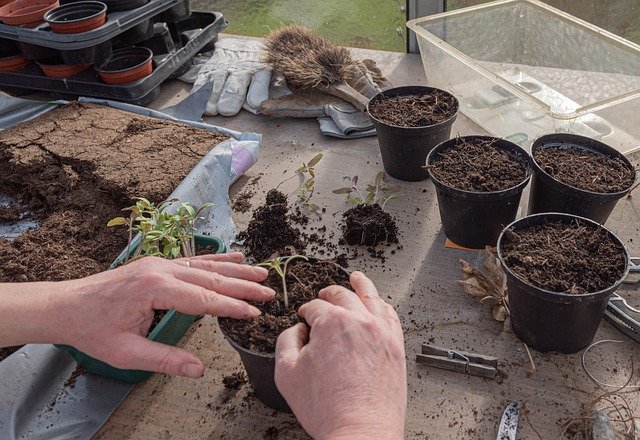
Repotting orchids is an important step in maintaining their root health. Orchids should be repotted every one to two years, or when the potting medium has broken down and is no longer providing adequate drainage.
When repotting an orchid, it is important to choose a pot with drainage holes to prevent water from accumulating in the pot. The potting medium should also be well-draining and provide adequate aeration to the roots.
To repot an orchid, gently remove it from its pot and remove any dead or damaged roots. Place the orchid in a new pot with fresh potting medium and water it thoroughly.
Prevention and Treatment
Preventing Leaf Browning
To prevent orchid leaves from turning brown, it is important to maintain a healthy growing environment. This includes providing adequate light, water, and humidity.
Overwatering is a common cause of leaf browning, so it is important to use a moisture meter to ensure the soil is not too wet. Orchids should be watered only when the soil is dry to the touch, and excess water should be drained away.
Fertilizer can also contribute to leaf browning, so it is important to use a balanced orchid fertilizer and dilute it properly before use. Avoid over-fertilizing, as this can cause salt buildup in the soil, which can lead to leaf browning.
Orchids should be kept in a well-ventilated area to prevent fungal and bacterial infections. It is also important to keep the growing area clean and free of debris, which can harbor pests and diseases.
Treating Brown Leaves
If orchid leaves have already turned brown, it is important to take action to prevent further damage. The first step is to identify the cause of the problem.
If the cause is overwatering, the orchid should be allowed to dry out and excess water should be drained away. If the cause is fertilizer burn, the orchid should be flushed with water to remove excess salt buildup.
In some cases, it may be necessary to remove the affected leaves. This should be done with sterile tools to prevent the spread of disease. If the entire plant is affected, it may be necessary to remove it from the growing area to prevent the spread of disease to other plants.
Prevention is the best cure for orchid leaf browning, but if the problem does occur, it is important to take action right away to prevent further damage. By maintaining a healthy growing environment and taking prompt action when problems arise, orchid growers can enjoy healthy, beautiful plants.
Conclusion
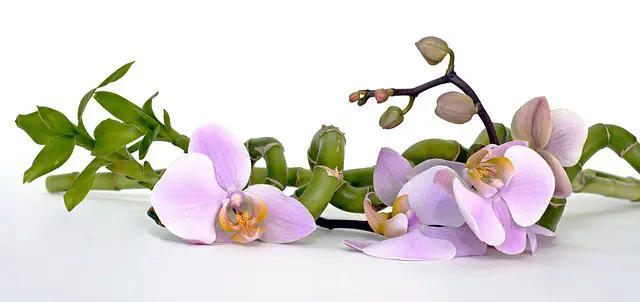
The tips of orchid leaves turning brown can be caused by a variety of factors. These can include over-fertilization, over-watering, dehydration, bacterial brown spot, salt build-up, inadequate relative humidity, and severe sunburn. It is important to identify the underlying cause of the problem before attempting to fix it.
One way to prevent the tips of orchid leaves from turning brown is to ensure that the orchid is receiving the appropriate amount of water and fertilizer. Orchids should be watered only when the potting mix is dry to the touch, and fertilizer should be applied at half the recommended strength every two weeks during the growing season.
Another way to prevent the tips of orchid leaves from turning brown is to maintain proper humidity levels. Orchids thrive in environments with humidity levels between 50% and 70%. This can be achieved by placing a tray of water near the orchid or by using a humidifier.
If the tips of orchid leaves do turn brown, it is important to take action quickly. This can include removing any affected leaves, adjusting the watering and fertilizing schedule, and increasing humidity levels. With proper care and attention, orchids can thrive and produce beautiful blooms for years to come.
Frequently Asked Questions
What causes orchid leaves to turn brown at the tips?
Brown tips on orchid leaves can be caused by a variety of factors, including dehydration, bacterial infections, low magnesium levels, salt damage due to over-fertilization, and pH imbalances. Over-fertilization and calcium deficiencies can also cause brown tips on orchid leaves.
How can I prevent my orchid leaves from turning brown?
To prevent orchid leaves from turning brown, make sure to water them properly, fertilize them regularly, ensure that they are getting enough sunlight, and maintain a consistent temperature and humidity level.
What are some common reasons for brown spots on orchid leaves?
Brown spots on orchid leaves can be caused by insufficient watering, overwatering, incorrect lighting, extreme temperature conditions, and nutrient deficiencies. If left untreated, these brown spots can spread throughout the entire leaf.
Is it safe to cut off brown parts of orchid leaves?
Yes, it is safe to cut off brown parts of orchid leaves. This will prevent further damage to the plant and promote new growth.
How often should I water my orchid to prevent brown leaves?
The frequency of watering your orchid will depend on the type of orchid, the environment it is in, and the season. Generally, orchids should be watered once a week, but it is important to monitor the moisture level of the soil and adjust watering accordingly.
Can overwatering cause orchid leaves to turn brown?
Yes, overwatering can cause orchid leaves to turn brown. Overwatering can lead to root rot, which can cause damage to the plant and result in brown leaves.

Hey, I’m Lisa and I’ve been an avid gardener for over 30 years. I love writing, talking and living in the garden! Feel free to connect with me on my socials below

